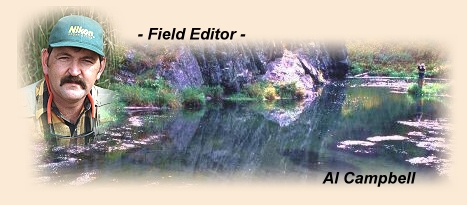|
Autumn is either a great time or a tough time for
most fishermen. It's a great time if you know what
to use, because the fish are usually looking to put
on some weight before the hard winter months set in.
It's a tough time because the many insect hatches of
summer are over, and many people don't know how to
deal with that. The secret to success, as always,
is in knowing what the fish are feeding on, and how
to match it.
During the spring and summer months, the insect life
in our streams and lakes is at or near maturity, so
the flies we use to imitate that life are usually
fairly large. As the summer progresses, each of the
insect species hatches, mates, lays their eggs, and
dies. By autumn, most if not all of the annual insects
have finished their life cycle and started over as
eggs. That means that most of the insect life in the
water is either small or very small, and clinging to
the bottom trying to live long enough to reach maturity.
That doesn't leave a lot of large or medium sized insects
on the dinner table for the fish to eat.
While a size 14 Adams dry fly is a good bet in May when
mayflies are hatching in that size, by October most of
the mayfly life in the streams and lakes is represented
by nymphs that started their lifecycle just a few months
before. That means those mayfly nymphs are roughly a
size 30, and not real active. The same is true for
caddisfly larvae. Although stonefly, dragonfly and
damselfly nymphs will usually be somewhat larger in
size, they still aren't present in open water often
enough to make many good meals for the fish.
It's time to look at this food thing a bit differently
than most fly fishermen do. With the exception of a
few late season hatches of mayflies and caddisflies
that fish really key in on for a short period of time
when they occur, something else is on their menu.
Fish need something that is large enough and/or
plentiful enough to provide more energy than they
expend to eat it. Forget your common dry fly fare.
That isn't what's on the menu during the fall and
winter months; at least not very often.
You might be thinking crayfish, and I know fish do
feed on them in the fall, but they aren't as active
around here after the water turns cold. Frogs and
other cold-blooded creatures are off the menu until
the water warms back up in the late spring. However,
minnows are still readily available and active.
Minnows also provide a substantial meal, and if a
fish can find and consume enough of them, it can
continue to grow during the cold months.
Although scuds and sowbugs live on a different life
cycle than most insects, they are often large enough
and available enough in the fall to provide some
feeding opportunities to hungry fish. This is
especially true in bodies of water than have a
healthy plant population.
Finally, midges usually have a much shorter life
cycle than most of the other aquatic insects, so
they are readily available to fish for most, if
not all of the year. Although small, they usually
hatch in such quantities that they offer a substantial
meal to the fish. If you think of them like popcorn
shrimp, you'll understand why they are valuable as
fish food. It takes a while, but I can fill up on
popcorn shrimp if I eat enough of them. The same
idea applies to midge hatches. Since midge hatches
are heavier in the cool months from October to April,
they are available in quantities large enough to provide
significant nutrition to feeding fish.
If you think about this subject for a while, you'll see,
it just makes sense. It makes even more sense to learn
what is available to fish in your area after the weather
starts cooling down and most of the insect hatches are
over for about 8 months. Knowing what's on the menu
can make the difference between a good day and a poor
day on the water. It's up to you to either learn what's
on that menu, or spend all your time trying to guess what
the fish are feeding on. In one case you can have a
fishing bonanza; in the other, you can be frustrated
by your lack of luck.
~ AC
|



